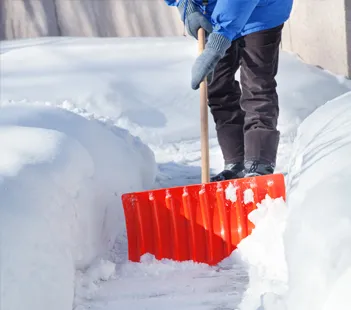January 01, 2017

For most people, snow removal is an expected chore. But, for some, the risk of a heart attack or back injury is a reality. If you are not in good physical condition or have existing heart disease or a personal history of stroke, you are at a higher risk for injury. Snow removal can be especially dangerous if you do not exercise regularly.
Heart Health
The combination of colder temperatures and physical activity increases the workload on the heart. When outdoors in cold weather, you should avoid sudden exertion, like lifting a heavy shovel full of snow or even walking through heavy, wet snow or snow drifts, which can strain your heart.
Back / Body Injuries
The most common injuries associated with snow removal include sprains and strains, particularly in the back and shoulders, as well as lacerations and finger amputations. The 2009 US Consumer Product Safety Commission notes the following snow removal statistics:
- Approximately 16,500 people were treated in hospital emergency rooms for injuries that happened while shoveling or removing ice and snow manually
- More than 6,000 people were injured using snow-blowers
Snow Remove Safety Tips
To help make snow removal safer, follow these tips for safer snow removal.
- Consult a doctor: If you have a medical condition, don’t exercise on a regular basis or are middle aged or older, meet with your doctor before exercising in cold weather.
- Dress appropriately: Light, layered, clothing provides both ventilation and insulation. It’s important to keep your head warm and wear mittens or gloves and thick, warm socks. Avoid falls by wearing shoes or boots with slip-resistant soles.
- Start early: Try to clear snow early and often. Begin removing snow when it begins to cover the ground to avoid dealing with packed, heavy snow.
- Pace Yourself: Snow removal is an aerobic activity. Take frequent breaks and prevent dehydration by drinking plenty of fluids. If you experience chest pain, shortness of breath, or other signs of a heart attack, stop the activity and seek emergency care by calling 911.
- Proper equipment: Use a shovel that is comfortable for your height and strength. Do not use a shovel that is too heavy or too long for you. Space your hands on the tool grip to increase your leverage. Use a small shovel or consider a snow thrower. The act of lifting heavy snow can raise blood pressure acutely during the lift. It is safer to lift smaller amounts more times, than to lug a few huge shovelfuls of snow. When possible, simply push the snow.
- Proper lifting: Try to push the snow instead of lifting it. If you must lift, do it properly. Squat with your legs apart, knees bent, and back straight. Lift with your legs. Avoid bending at the waist. Scoop small amounts of snow into the shovel and walk to where you want to dump it. Holding a shovelful of snow with your arms outstretched puts too much weight on your spine. Never remove deep snow all at once. Do it in pieces.
- Safe technique: Do not throw the snow over your shoulder or to the side. This requires a twisting motion that stresses your back.
- Avoid eating a heavy meal prior to or soon after shoveling: Eating a large meal can put an extra load on your heart.
- Learn the heart attack warning signs and listen to your body, but remember this: Even if you’re not sure it’s a heart attack, have it checked out (tell a doctor about your symptoms). Minutes matter! Fast action can save lives — maybe your own. Don’t wait more than five minutes to call 911
- Avoid drinking alcoholic beverages before or immediately after shoveling: Alcohol may increase a person’s sensation of warmth and may cause them to underestimate the extra strain their body is under in the cold.
- Be aware of the dangers of hypothermia: Heart failure causes most deaths in hypothermia. To prevent hypothermia, dress in layers of warm clothing, which traps air between layers forming a protective insulation. Wear a hat because much of your body’s heat can be lost through your head.
- Learn CPR: Effective bystander CPR, provided immediately after sudden cardiac arrest, can double or triple a victim’s chance of survival. Hands-only CPR makes it easier than ever to save a life. If an adult suddenly collapses, call 911 and begin pushing hard and fast in the middle of the victim’s chest until help arrives.
Never second guess a heart attack!
If your chest starts hurting, you feel lightheaded, short of breath, your heart starts racing, or some other physical change makes you nervous, call 911.
Download Snow Removal Safety Tips PDF
© 2012 Denver Health

